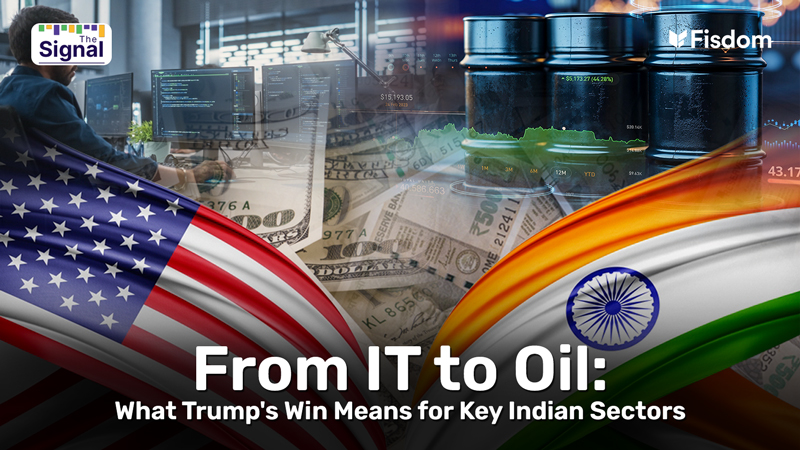
The recent victory of Donald Trump in the 2024 U.S. Presidential Election has significant implications for the Indian economy and financial markets. A Republican sweep of the White House, Senate, and possibly the House of Representatives is anticipated to fast-track Trump’s policy agenda. This development signals notable shifts across sectors in India, from corporate taxes and trade dynamics to immigration laws and energy policy. Below, we explore the likely effects of Trump’s policies on the Indian economy and key sectors.
- USD-INR Exchange Rate and Currency Impacts
Trump’s policies are likely to emphasize domestic economic growth through tax cuts, infrastructure spending, and pro-business policies. A strengthening U.S. dollar could increase pressure on emerging market currencies like the Indian Rupee (INR), potentially making imports more expensive for India. This could lead to inflationary pressures within India, although it may also create opportunities for Indian exporters, as the lower rupee makes their products more competitively priced in global markets. Investors should closely monitor the USD-INR exchange rate as currency fluctuations can have significant impacts on profitability across sectors.
- Indian Bond Yields and Foreign Institutional Investment (FII)
Trump’s win is expected to push U.S. bond yields higher, particularly if pro-growth policies trigger increased demand for debt. Higher bond yields in the U.S. often attract global capital flows, potentially drawing investment away from emerging markets like India. This shift could reduce foreign investments in Indian markets, leading to volatility in Indian bond yields and increased pressure on equity markets. A stronger U.S. dollar and the shift in FII flows could, therefore, impact Indian asset prices, creating both challenges and opportunities for investors.
- Corporate Tax Reductions and Investment in U.S. Manufacturing
Trump’s proposed reduction in U.S. corporate tax rates from 21% to 15% is aimed at fostering domestic manufacturing. For Indian companies with a significant presence in the U.S., such as those in IT services and manufacturing, this could create new opportunities. However, a higher growth rate in U.S. manufacturing might also mean reduced outsourcing, impacting Indian service providers. Nonetheless, companies in sectors like manufacturing and supply chain solutions may see an increase in demand due to rising U.S. corporate investments.
- Indian IT and Immigration Policies
In Trump’s first term, his administration tightened H-1B visa requirements, leading to higher rejection rates and increased costs for Indian IT companies that rely on foreign labor. However, Indian IT services players have since bolstered their local hiring in the U.S., reducing their reliance on H-1B visa holders. This preparation means that any renewed restrictions on immigration will likely have a smaller impact on Indian IT services, though the broader sentiment around immigration policies may still influence market sentiment.
- Trade Tariffs, Protectionism, and the ‘China+1’ Strategy
A key feature of Trump’s platform has been his protectionist stance on trade, including imposing high tariffs on Chinese goods. Such tariffs could have both direct and indirect effects on India. The ‘China+1’ strategy—where companies diversify their supply chains away from China—is likely to accelerate, opening opportunities for Indian companies in sectors such as chemicals, electronics manufacturing, auto ancillaries, and solar panels. With increased U.S. tariffs on Chinese goods, Indian exporters could see a growth in demand as global firms seek alternatives to Chinese suppliers.
- Energy Policy and Impact on Oil Prices
Trump’s emphasis on supporting U.S. oil and gas production could lead to a decline in global oil prices, which would benefit India as a net importer of crude oil. Lower oil prices would ease inflationary pressures and improve India’s current account balance. However, Trump’s potential disengagement from international conflicts could create new dynamics in global energy markets. A reduction in geopolitical tensions in areas like the Middle East could also stabilize oil prices further, benefitting India’s economy through lower fuel costs.
- Pharmaceuticals and Local Manufacturing Incentives
Trump’s administration has voiced support for reducing U.S. dependence on foreign pharmaceutical suppliers, particularly from China. This focus on local manufacturing could lead to some reshoring of pharmaceutical production. However, India, as a major supplier of generic drugs and active pharmaceutical ingredients (APIs), stands to benefit from reduced competition from Chinese manufacturers. Indian companies engaged in contract development and manufacturing could gain from this shift, as their low-cost base and established supply chains make them attractive alternatives.
- Impact on Real Estate and Housing Markets
A delay in interest rate cuts in India, potentially spurred by higher U.S. rates under Trump’s policies, could impact the Indian real estate market. Higher borrowing costs in India could reduce demand in the affordable housing sector, where interest rates play a major role in consumer decisions. This slowdown in real estate could have broader economic repercussions, especially in the context of mortgage financing and housing-linked industries.
- Metals, Commodities, and Tariff Impact
Trump’s preference for tariffs on imports and regionalization of commodity markets could lead to higher global metal prices, benefiting Indian metal exporters. Increased U.S. infrastructure spending could drive up demand for metals, providing an opportunity for Indian firms that export to the U.S. However, for domestic manufacturers in India, this could also raise input costs, affecting profitability if commodity prices continue to rise.
- Textiles and U.S. Economic Growth
A pro-business Trump administration could support a stronger U.S. economy, boosting consumer spending on retail goods, including imported textiles and apparel. For India, which is a major exporter of textiles to the U.S., this could mean increased demand and a potential rise in exports. Indian textile companies may see opportunities to expand market share in the U.S. as a result of Trump’s economic policies.
- Long-Term Impact on Inflation and Interest Rates
Trump’s expansionary fiscal policies, which include tax cuts and infrastructure investment, may increase inflationary pressures. This could limit the Federal Reserve’s flexibility in lowering interest rates, keeping U.S. rates elevated. For India, a strong U.S. dollar driven by high interest rates would impact exporters by making Indian goods more expensive globally, and it could raise the cost of dollar-denominated debt for Indian companies.
Conclusion: Navigating the Shifts
The impact of Trump’s policies on India spans multiple sectors, creating both opportunities and challenges. While sectors like IT, pharmaceuticals, and textiles could benefit from Trump’s protectionist policies and economic expansion, others like automobiles and renewable energy may face headwinds. Indian investors should closely monitor trends in FII flows, bond yields, currency rates, and sector-specific developments to make informed decisions in a dynamic global environment. The upcoming months will be critical as Trump’s policies take shape and their effects ripple through the global economy.
Market this week
| 04th Nov 2024 (Open) | 08th Nov 2024 (Close) | %Change | |
| Nifty 50 | ₹ 24,316 | ₹ 24,148 | -0.7% |
| Sensex | ₹ 79,713 | ₹ 79,332 | -0.5% |
Source: BSE and NSE
- The broader indices underperformed, with the BSE Smallcap index dropping over 1% in the week ending November 8.
- Benchmark indices experienced high volatility, driven by weak Q2 earnings, continued FII selling, and a lack of positive momentum from rate cuts by the Bank of England and the Federal Reserve.
- Sector-wise, Nifty Realty lost over 4%, Nifty Media declined by 3.2%, Nifty Energy fell by 3%, and Nifty Oil & Gas slipped nearly 2%.
- Conversely, Nifty IT index gained 4%, while Nifty PSU Bank index rose by 1%.
- Foreign Institutional Investors (FIIs) sold equities worth Rs 14,485.12 crore during the week, while Domestic Institutional Investors (DIIs) made net purchases totaling Rs 9,239.03 crore.
Weekly Leaderboard
| NSE Top Gainers | NSE Top Losers | ||||
| Stock | Change (%) | Stock | Change (%) | ||
| Apollo Hospitals | ▲ | 5.44 % | Trent | ▼ | (10.96) % |
| M&M | ▲ | 5.34 % | Coal India | ▼ | (7.02) % |
| Tech Mahindra | ▲ | 4.93 % | Asian Paints | ▼ | (5.41) % |
| HCL Tech | ▲ | 4.34 % | Hindalco Ind | ▼ | (5.27) |
| Infosys | ▲ | 4.13 % | Grasim Indus. | ▼ | (5.24) % |
Source: BSE
Stocks that made the news this week:
Tata Motors reported a consolidated net profit decline of 11% YoY to Rs 3,343 crore for Q2 FY25, impacted by weaker performances in its Jaguar Land Rover unit and commercial vehicles segment. Revenue also fell by 3.5% to Rs 1.01 lakh crore due to lower sales volumes, missing analyst expectations, which had forecast a net profit increase and flat revenue.
State Bank of India (SBI) posted a 28% YoY increase in net profit for Q2 FY25, reaching Rs 18,331 crore, up from Rs 14,330 crore in the same period last year. The bank’s interest income grew 12.3% YoY to Rs 1.14 lakh crore, while net interest income rose 5.4% to Rs 41,620 crore in the July-September quarter.
On November 8, domestic institutional investors (DIIs) net purchased Rs 1,748 crore in shares, while foreign institutional investors (FIIs) net sold Rs 3,404 crore, per NSE data. Year-to-date, FIIs have net sold Rs 2.73 lakh crore, whereas DIIs have net bought Rs 5.39 lakh crore in Indian equities.














